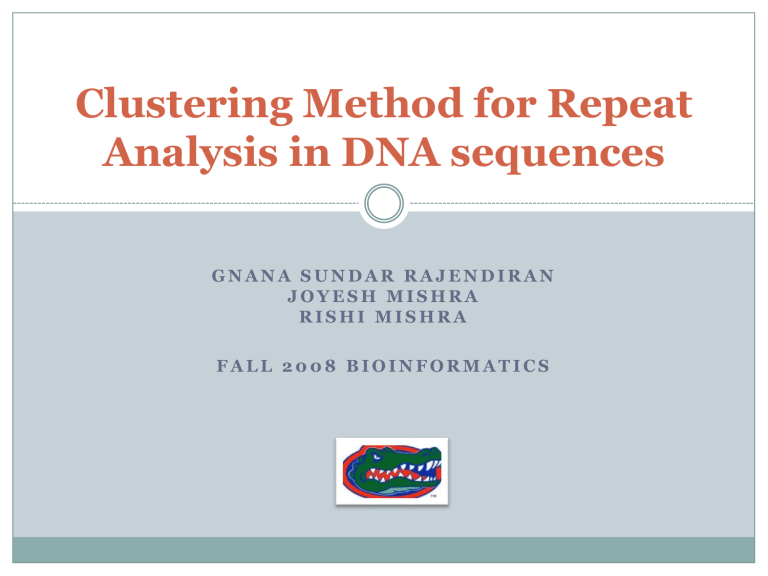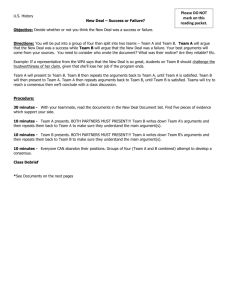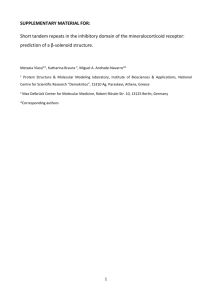Clustering Method for Repeat Analysis in DNA sequences

Clustering Method for Repeat
Analysis in DNA sequences
G N A N A S U N D A R R A J E N D I R A N
J O Y E S H M I S H R A
R I S H I M I S H R A
F A L L 2 0 0 8 B I O I N F O R M A T I C S
Abstract
Implement a Proposed Clustering Technique by
Volfovsky et al. for Repeat Analysis
Distribute Merging Repeats into Classes/Clusters based on Similarity Measures
Why analyze repeats?
Algorithm Description
Selection using RepeatMatch
Steps
1.
2.
Preprocessing
Merging and Repeat Map Generation
3.
Classification
4.
BLAST searches & further merging of
Clusters
Results
RepeatMatch
Uses Suffix Tree algorithm to determine all the exact repeats in a given sequence
It is a part of the MUMmer package used for the rapid alignment of very large DNA and amino acid sequences.
Example…
Forward & Reverse Complement Repeats
Definitions
Exact Repeat: Subsequence that occurs in DNA at least twice.
Exact repeat is represented by pair of co-ordinates (A1,A2) delimiting its location in the genome sequence and by the repeat length.
Maximal Repeat: Repeat that can not be extended in either direction without incurring a mismatch
Initial Repeat Set: Set of repeats chosen initially, from which the repeat classes will be constructed
Definitions
Preprocessing
Output from RepeatMatch is used to partition the original genome sequence
Each partition point has a reference to the pair coordinates (A1, A2) and repeat length l
For each repeat starting at co-ordinates A1 and A2, with length l, this list will include both (A1, A2, l) and
(A2, A1,l)
Merging & Repeat Map Generation
This procedure works by repeatedly working together two exact repeats that either overlap or that occur within a limited distance(a gap) of each other.
Significant subsequences of the new merging repeats appear at least twice in the genome sequence.
Merging with Gap
Merging with Overlap
Merging with Gap
Given 2 partition points: p
1
= (A
1
, A
2
, l
A
) and p
2
= (B
1
, B
2
, l
B
) [A
1
< B
1
]
Compute the distance between the non-overlapping repeats as d(p
1
,p
2
) = max(0, B
1
- A
1
- l
A
+ 1)
Given a maximum Gap size G > 0
Sequences corresponding to p
1 d(p
1
, p
2
) < G and p
2 are merged if
Merging with Overlap
Merges sequences which are partially identical
Overlap of 2 sequences is denoted as: o(p
1
, p
2
) = max(o, A
1
+ l
A
– B
1
+ 1) for A
1
<B
1
Given a minimum overlap proportion op, where 0 <= op
<= 1, repeat points (A
1
, A
2
, l
A
) and (B
1
, B
2
, l
B
) are merged if at least one of the four repeats has overlap satisfying o(p
1
, p
2
) > op min(l
A
, l
B
)
op : Interpreted as a fraction of the shorter of the 2 repeats. E.g. if op = 0.75, the two overlapped sequences are merged if the length of their overlap is at least 75% of the length of the shorter sequence.
Output: Merging Repeat
The new sequence is defined as merging repeat with starting position M = A
+ l
A
, B
1
+ l
B
) – A
1
1 and with length l
M
= max(A
1
A data structure stores with each merging repeat its start co-ordinate, the length(n
M
), and a list of references to itself and to other repeats.
Classification
If a merging repeat has at least one reference in common with one another, then they belong to the same class
If a merging repeat has references that belong to multiple distinct classes, then those classes are combined into one.
If a merging repeat contains no reference to an existing class, then the merging repeat forms a new class.
BLAST searches and further merging
To merge similar but non-exact repeats
Search all merging repeats against all others
A local BLAST database is created with all repeat sequences using formatdb
Classes are merged if any of their underlying sequences have a BLAST E-value less than a User-
Specified Threshold when compared to any sequence in another class
If a class appears in multiple similarity pairs, all these similar classes are merged with the original class
Results
Results (contd.)
Results (contd.)
Results (contd.)
Results (contd.)
Results (contd.)
Results (contd.)
What’s Next?
The results collected help to cluster similar repeats and generate a database.
This DB, in future, can be used to find Similar
Repeats faster.
Also, if on future classification, we find common traits among repeats, they can be analyzed only for that cluster alone.
Resources
Softwares Used:
RepeatMatch (MUMmer 3.0)
BLAST (formatdb, blastall)
MS Excel 2007
Programmming Language Used:
C++, UNIX Shell Script
Source for Project & Presentation
www.cise.ufl.edu/~jmishra/bioinformatics.html
References
Volfovsky N., Haas Brian J. and Salzberg Steven L. A clustering method for repeat analysis in DNA sequences, 2001
Mummer software : http://mummer.sourceforge.net/
http://www.ncbi.nlm.nih.gov/staff/tao/URLAPI/
blastall, formatdb
www.ncbi.nlm.nih.gov/BLAST/
References
http://www.tigr.org
http://www.animalgenome.org/blast/docs/blast_faq.
html
Of course, Wikipedia …
Data obtained from: ftp://ftp.ncbi.nih.gov/genomes/Bacteria/





